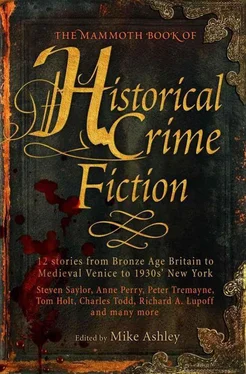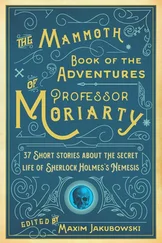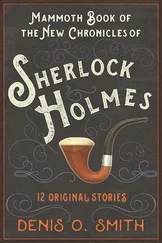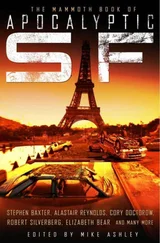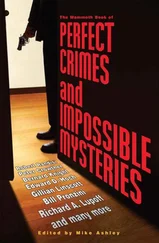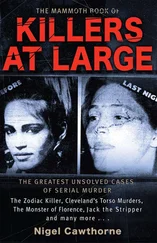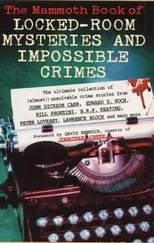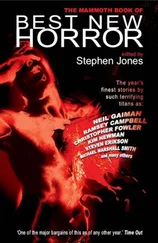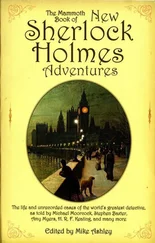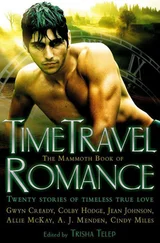The Mammoth Book of Historical Crime Fiction
INTRODUCTION
Return to the Crime Scene
The stories in this anthology cover over four thousand years of crime. We travel from the Bronze Age of 2300 BC to the eve of the Second World War, passing through ancient Greece and Rome, the Byzantine Empire, medieval Venice and seventh-century Ireland, before heading for Britain and the United States.
All except one of these stories are brand new, written especially for this anthology. This is my fifteenth anthology of historical crime and mystery fiction (for those interested there is a full list on the ‘Also in the series’ page), and this time I wanted to feature longer stories. This allows the author to concentrate on the historical setting, character and mindset of the period, so that not only do these stories present fascinating crimes and puzzles, but you also get to know the people and their world in more detail. There are twelve stories in this volume compared to the usual twenty or twenty-five; they are almost like mini-novels, allowing a greater understanding of the time.
I’ve also broadened the coverage. Rather than focus solely on a mystery and its solution, here we have a broader range of crimes and a wider variety of those trying to solve them. Hence you will find, among others, a young girl in Bronze Age Britain trying to understand whether a series of deaths over a period of time were accidental or deliberate; an icon-painter in ancient Byzantium, suddenly out of work when all icons are banned, who becomes embroiled in a case of deception; a priest-finder trying to track down attempted regicides; Charles Babbage and the young Ada Byron trying to crack a coded message and stop a master criminal; and New York detectives on the lookout for Butch Cassidy and the Sundance Kid.
Your guides are twelve of the leading writers in historical crime fiction who are about to bring the past alive. Let us return to the scene of the crime.
— Mike Ashley
Archimedes and the Scientific Method
TOM HOLT
Tom Holt is best known for his many humorous fantasy novels, which began with Expecting Someone Taller (1987) and include Who’s Afraid of Beowulf? (1988), Paint Your Dragon (1996) and The Portable Door (2003) — the last heralding the start of a series featuring the magic firm of J. Wellington Wells from Gilbert and Sullivan’s light opera The Sorcerer . But Holt is also a scholar of the ancient world and has written a number of historical novels including The Walled Garden (1997), Alexander at the World’s End (1999) and Song for Nero (2003).
The following story, which is the shortest in the anthology and so eases us in gently, features one of the best known of the ancient Greek scientists and mathematicians, Archimedes. He lived in the third century BC in the city of Syracuse, in Sicily, under the patronage of its ruler Hieron II. It is a shame that the one enduring image we all have of Archimedes is of him leaping out of his bath shouting “Eureka”, meaning “I have found it.” But it does encapsulate how Archimedes operated. When presented with a scientific problem he applied his whole self to it using scientific principles, many of which he had propounded. Archimedes unified much scientific theory into a coherent body of thought which allowed him to apply what he regarded as the scientific method. It probably made him the world’s first forensic investigator.
“No,” I told him. “Absolutely not.”
You don’t talk like that to kings, not even if they’re distant cousins, not even if they’re relying on you to build superweapons to fight off an otherwise unbeatable invader, not even if you’re a genius respected throughout the known world. It’s like the army. Disobeying a direct order is the worst thing you can possibly do, because it leads to the breakdown of the machine. You’ve got to have hierarchies, or you get chaos.
He looked at me. “Please,” he said.
He, for the record, was King Hiero the Second of Syracuse; my distant cousin, my patron and my friend. Even so. “No,” I said.
“Forget about the politics,” he said. “Just think of it as an intellectual problem. Come on,” he added, and that little-boy look somehow found its way back on to his face. Amazing, how he can still do that, after the life he’s lived. “You’ll enjoy it, you know you will. It’s a challenge. You like challenges. Isn’t that what it’s all about, finding answers to questions?”
“I’m busy,” I told him. “Really. I’m in the middle of calculating the square root of three. If I stop now — ”
“The what of three what?”
“I’ll lose track and have to start all over again. Four years’ work, wasted. I can’t possibly drop that just to help out with some sordid little diplomatic issue.”
One of these days, people tell me, one of these days I’ll get myself into real trouble talking to important people like that. Don’t be so arrogant, people tell me. Who do you think you are, anyhow?
“Archimedes.” He wasn’t looking at me any more. He was staring down at his hands, folded in his lap. It was then I noticed something about him that I’d never realized before. He was getting old. The bones of the huge hands stood out rather more than they used to, and his wrists were getting thin. “No,” I said.
“You never know,” he went on, “it might lead to a great discovery. Like the cattle problem or the thing with the sand. Those were stupid little problems, and look where they ended up. For all you know, it could be your greatest triumph.”
I sighed. You think somebody knows you, and then they say something, and it’s obvious they don’t. “No,” I said. “Sorry, but that’s final. Get one of your smart young soldiers on to it. That Corinthian we had dinner with the other evening; sharp as a razor, that one; I’m sure he’d relish the chance to prove himself. You want someone with energy for a job like this. I’m so lazy these days I can hardly be bothered to get out of bed in the morning.”
He looked at me, and I could see I’d won. I’d left him no alternative but to use threats — do this or it’ll be the worse for you — and he’d decided he didn’t want to go there. In other words, he valued our friendship more than the security of the nation.
“Oh, all right,” I said. “Tell me about it.”
* * *
The extraordinary thing about human beings is their similarity. We’re so alike. Dogs, cows, pigs, goats, birds come in a dazzling array of different shapes and sizes, while still being recognizable as dogs, cows, pigs, goats, birds. Human beings scarcely vary at all. The height difference between the unusually short and the abnormally tall is trivial compared with other species. The proportions are remarkably constant — the head is always one-eighth of the total length, the width of the outstretched arms is always the same as the length of a single stride, and the stride is so uniform that we can use it as an accurate measurement of distance. Human beings have two basic skin colours, three hair colours, and that’s it. Just think of all the colours chickens come in. It’s a miracle we can ever tell each other apart.
That said, I can’t stand Romans. They’re practically identical to us in size, shape, skin and hair colour, and facial architecture. Quite often you can’t tell a Roman from a Syracusan in the street — no surprise, when you think how long Greeks and Italians have shared Sicily. I’ve known Romans who can speak Greek so well you wouldn’t know they weren’t born here; not, that is, unless you listen to what they actually say.
Читать дальше
